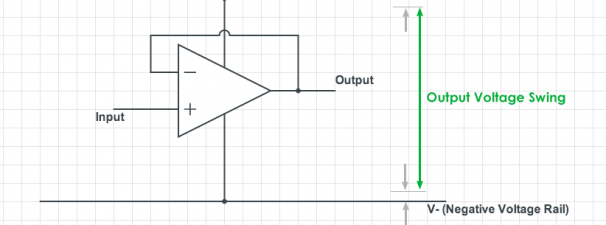An opamp usually doesn’t know where the “Ground” terminal, so one can normally operate an opamp from a dual power supply (i.e. also called split power supply, +/-V supply voltages) or from single-supply voltages. As long as you don’t exceed the Maximum Ratings specified by the Opamp datasheet, you can operate opamps using either single or dual supplies.
When you browse manufacturer websites though, you often see some Opamps specified as “Single-supply” and some as “Rail-to-Rail” opamps… what do they mean by this?
Before we highlight the difference between a “single-supply” and a “rail-to-rail” opamp, let’s show how a “normal” opamp behaves.
“Normal” Opamp
A normal Opamp’s output cannot swing very wide. It’s maximum output is limited and cannot come close to it’s positive or negative voltage rails. Most Opamps behave like this. These Opamps works best ideally used with dual power supply voltages, because you’ll have a wider voltage swing to work with! For example, a +/-5V split power supply is actually a 10Volts range. If you use a normal opamp in a single supply configuration (for example +5VDC), your output swing will be very limited. You cannot come close to 0 volts (or your Ground), and you also cannot come close to +5V.
Rail-to-Rail Opamp
“Rail-to-Rail Output” means the output voltage swing can come close to it’s V+ and V- supply voltages, often within 10mV to 100mV of it’s V+ or V- rails. They’re usually great for use in low-voltage “Single Supply” systems, like a 5Volt DC system, because you can maximize the signal you can get out of your opamp. (Remember, V- doesn’t have to mean a negative supply voltage, it could also be your Ground.)
Single Supply Opamp
While any Opamp can be used either in dual or single power supply configuration, true “Single-supply” opamp have a certain capabilities unique to “single-supply” opamps. They have a wider output voltage swing compared to “normal” opamps, (but not as wide as rail-to-rail Opamps). Their negative output swing can come very close to V- (or Ground), within 10mV to 500mV. But their positive voltage swing may not come close to the positive voltage rail V+.





